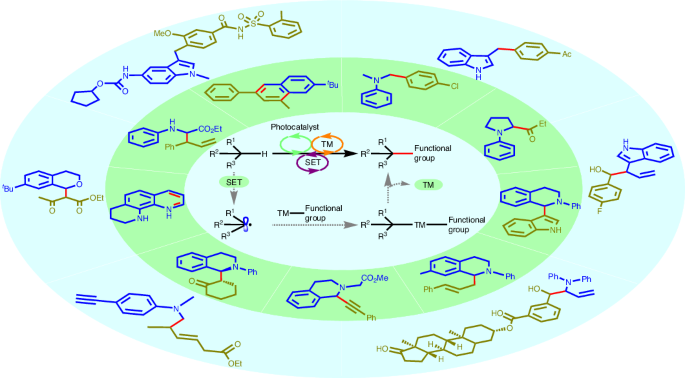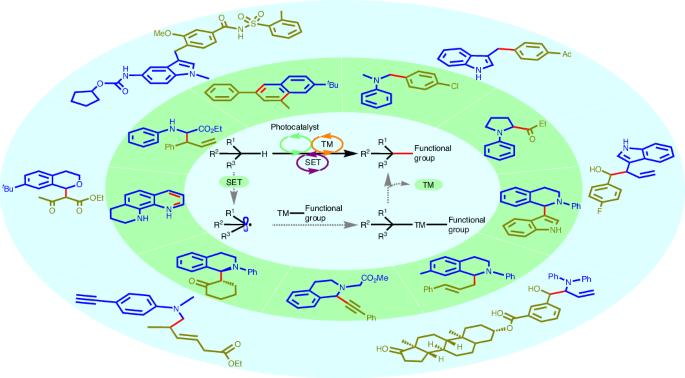Metallaphotoredox catalysis for sp3 C–H functionalizations through single-electron transfer
IF 44.6
1区 化学
Q1 CHEMISTRY, PHYSICAL
引用次数: 0
Abstract
Metallaphotoredox catalysis merging photocatalysis and transition metal catalysis is now the most efficient platform for sp3 C–H functionalizations due to its very efficient activation and transformation capability. In such a process, photocatalysis is usually in charge of C–H bond activation to generate an sp3-hybridized carbon-centred radical, whereas transition metal catalysis is in charge of the subsequent transformation of this radical. Here we review advances in sp3 C–H functionalizations under matallaphotoredox catalysis via photocatalytic single-electron transfer mechanisms as opposed to hydrogen atom transfer processes. The delineation of these advancements is initially organized according to distinct sp3 C–H bonds and subsequently categorized by various transition metal catalytic systems. We encompass a thorough exploration of diverse metallaphotoredox catalysis strategies, along with their synthetic applications and mechanisms. Similarities and differences between these strategies are described to inspire new reaction designs, thus promoting further development of this field. The merger of photocatalysis and transition metal catalysis has broadened the scope of chemical reactivity in organic synthesis. This Review provides an overview of the use of metallaphotoredox catalysis for sp3 C–H functionalizations that occur via single-electron, rather than hydrogen atom transfer.


通过单电子转移实现 sp3 C-H 功能化的金属光氧催化
光催化与过渡金属催化相结合的金属光氧催化因其高效的活化和转化能力而成为目前最有效的 sp3 C-H 功能化平台。在这一过程中,光催化通常负责 C-H 键的活化,以生成 sp3 杂化的碳中心自由基,而过渡金属催化则负责该自由基的后续转化。在此,我们回顾了通过光催化单电子转移机制(而非氢原子转移过程)在母萘氧化催化下进行 sp3 C-H 功能化的进展。我们首先根据不同的 sp3 C-H 键对这些研究进展进行了划分,然后按照各种过渡金属催化系统进行了分类。我们深入探讨了各种金属萘氧化催化策略及其合成应用和机制。我们描述了这些策略之间的异同,以启发新的反应设计,从而促进这一领域的进一步发展。
本文章由计算机程序翻译,如有差异,请以英文原文为准。
求助全文
约1分钟内获得全文
求助全文
来源期刊

Nature Catalysis
Chemical Engineering-Bioengineering
CiteScore
52.10
自引率
1.10%
发文量
140
期刊介绍:
Nature Catalysis serves as a platform for researchers across chemistry and related fields, focusing on homogeneous catalysis, heterogeneous catalysis, and biocatalysts, encompassing both fundamental and applied studies. With a particular emphasis on advancing sustainable industries and processes, the journal provides comprehensive coverage of catalysis research, appealing to scientists, engineers, and researchers in academia and industry.
Maintaining the high standards of the Nature brand, Nature Catalysis boasts a dedicated team of professional editors, rigorous peer-review processes, and swift publication times, ensuring editorial independence and quality. The journal publishes work spanning heterogeneous catalysis, homogeneous catalysis, and biocatalysis, covering areas such as catalytic synthesis, mechanisms, characterization, computational studies, nanoparticle catalysis, electrocatalysis, photocatalysis, environmental catalysis, asymmetric catalysis, and various forms of organocatalysis.
 求助内容:
求助内容: 应助结果提醒方式:
应助结果提醒方式:


